All about white roses
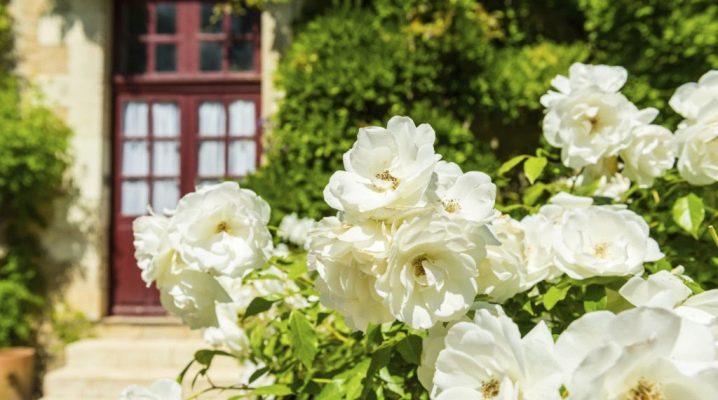
Flowers are an integral part of life that can please the eye and serve as a wonderful gift. This is especially true for roses. Such flowers can not only be bought, but also grown independently in your own flower bed.
White roses have recently begun to enjoy particular popularity, but not everyone knows what is their difference from other species, in addition to color. This is what will be discussed below.

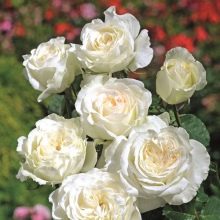

Peculiarities
The main feature of this variety is its color - white. It is customary to use such roses at weddings or as a gift for a very close person.
Another feature is a great combination with other colors. This applies not only to their varieties, but also to colors - with the help of white roses, you can create stunning and harmonious combinations.
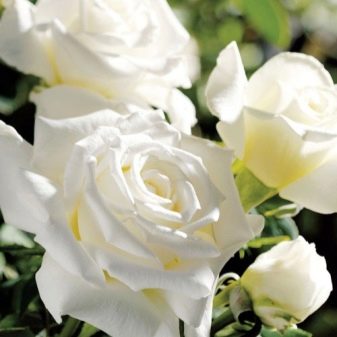

Varieties
Before you "settle" a white rose in your garden, you should familiarize yourself with these varieties, because each of them has its own characteristics and growing conditions.
Group classification
The first step is to determine the group to which the plant belongs, and these groups, in turn, are four. Absolutely every variety was created as a result of crossing parental species with each other.

The main groups of white roses.
- Tea-hybrid. It is she who is considered the most popular and widespread among all the others. These roses were bred after crossing the tea and remontant roses. These plants have increased resistance to various diseases, which cannot be said about their frost resistance. The stems of such roses are very tough, and their height can reach 1.5 meters. The color of the leaves is dark green with a slight sheen. The average size of one flower is about 14 centimeters in diameter, and they are located in 2-3 pieces on one shoot, which greatly simplifies the process of cutting.
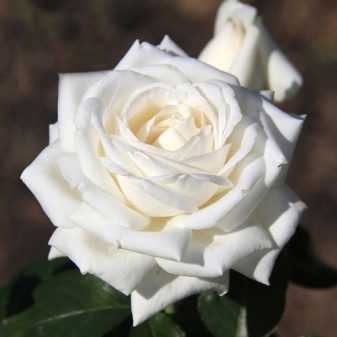
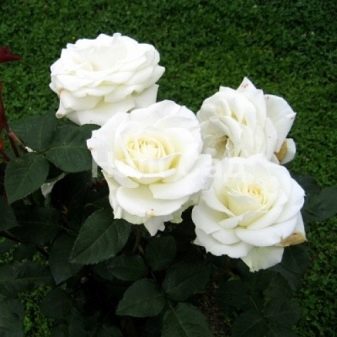
- Floribunda. Such a group appeared as a result of crossing the tea and polyanthus roses. The height of the bush is from 40 to 150 centimeters. The shoots are not very tough, and the inflorescences are collected in bouquets. Floribunda is resistant to rain, disease, and severe frost.
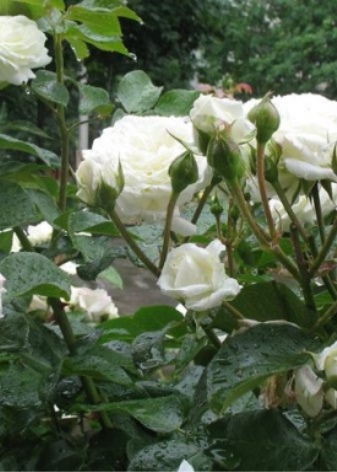
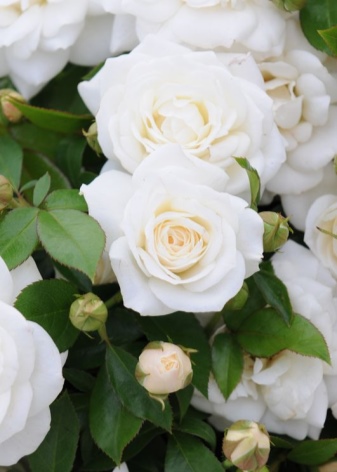
- Climbing. Such plants are obtained after an extremely complex process of hybridization of several species at once. But gardeners tend to prefer this particular type. It is distinguished by its long shoots and lush flowers.
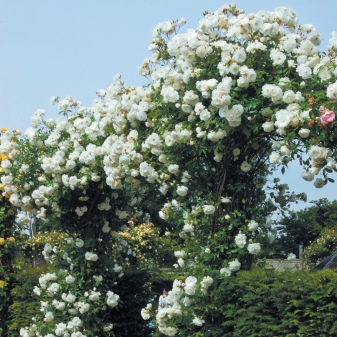
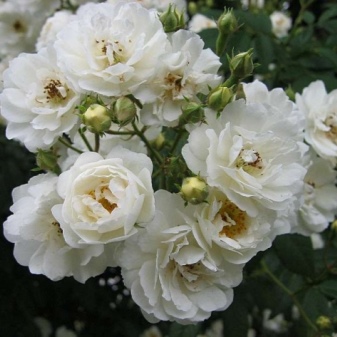
- Groundcover. Such plants appear after crossing a miniature and climbing rose. There are quite a few small leaves on the shoot, and the plant itself has a fairly good frost resistance.
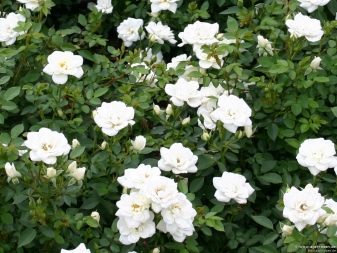
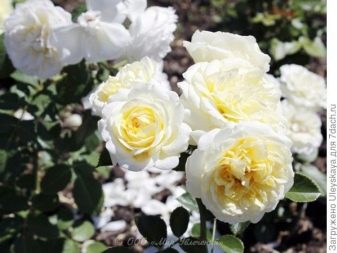
Description of varieties
Hybrid tea varieties
- White Christmas. This rose was first bred in the United States, after which it became widespread throughout the world. The bush of the plant is not wide, and the shoots are erect, their length is about 100 centimeters. The leaves have a very bright green color, the diameter of the buds ranges from 7 to 14 centimeters. White Christmas is distinguished by its very abundant and repeated blooming, as well as a pleasant aroma.
- Metropolitan. It was bred by the French in 2003. The bushes are quite tall, with strong shoots, on which a lot of foliage of a dark green hue grows. The buds are distinguished by a special shape - the edges are slightly protruding. The aroma of the plant is also very remarkable - the smell strongly resembles the aroma of lilies and bananas.
- Pascals. Bred in Belgium with extremely high resistance to adverse conditions. The variety is unpretentious. About five years ago, he received the title of "the most beautiful in the world." The plant has strong and straight shoots, the height of which is about 176 centimeters. The greens have a rich, pleasant color. Another interesting difference is that the buds open at a slow pace. At the very beginning, they are creamy in color, but over time it becomes much whiter.
- Mount Shasta. The most recent variety belonging to the hybrid tea group. It is distinguished by powerful and strong bushes. There are erect shoots, the height of which varies from 90 to 120 centimeters. The leaves have a dull green tint. Mount Shasta differs from Pascals in a whiter color of buds. Their sizes can reach 15 centimeters in diameter, which is very good.
- Winchester Cathedral. For lovers of everything old-fashioned and elegant, the Winchester rose was bred. It is a re-flowering shrub about one meter in size. A rose with a pleasant almond scent begins to bloom at the very beginning of the season.


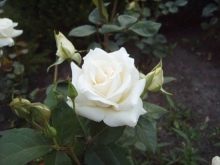
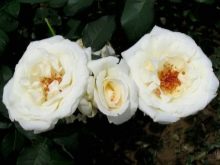
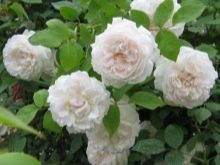
Floribunda varieties
The floribunda group includes the following varieties.
- La Paloma. This variety is of German origin, and it is not very large in size - only 60-80 centimeters. Nevertheless, its branches are very powerful, covered with dark leaves. Each individual brush has 3-8 flowers, and the size of one is at least 8 centimeters. The shade of such buds is light cream, and the core is yellow. But over time, the bud becomes completely white.
- White Roadrunner. A very popular variety with low bushes and snow-white buds. Differs in special frost resistance and resistance to various diseases.
- "White Bouquet". This variety, like the previous two, was bred in Germany. The bushes are low, and the shoots are branched. White Bouquet is highly regarded for its long flowering time and abundance.
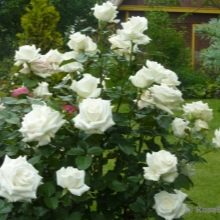
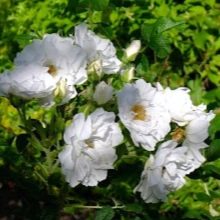

Climbing varieties
The climbing rose group includes such varieties.
- Long John Silver. This variety was bred in America in 1933. Such flowers are distinguished by their rather powerful and tall bushes. The average height is 3.5 meters and the width is 2.5. The leaves on the branches are medium in size and round. Inflorescences are located very tightly to each other, 3-4 pieces on one shoot.
- White Dorothy Perkins. This rose first appeared in England in 1903. It has twigs, the length of which varies from 2 to 3 meters. Flowers appear on them, but only once for the entire season. This variety is not particularly popular, because it has practically no resistance to powdery mildew.
- "Waist". The height of such a plant is no more than 4 meters. Flowering occurs in whole caps of 20-90 inflorescences.
- "Iceberg". The "Iceberg" bud size is 9 centimeters. The plant itself is branchy, capable of becoming an excellent hedge. Sometimes you can find 15 snow-white buds on one inflorescence. The variety is perfect for growing in the Moscow region.
- Snow Goose. A variety with an interesting name and a decent height (from 1.5 to 5 meters) has won the hearts of many gardeners with its small creamy flowers. The plant has a very pleasant aroma, and on one inflorescence there are from 3 to 6 buds.
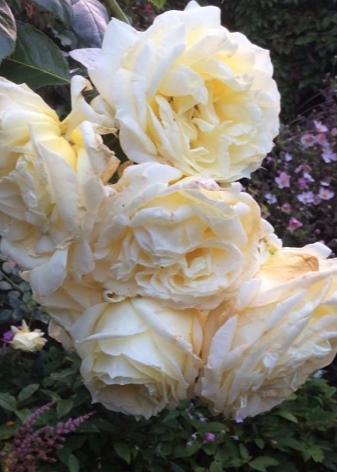



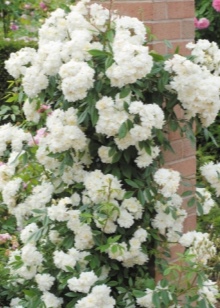
Ground cover varieties
The last group is ground cover roses.
- "Arctic". This variety is originally from Germany. On its branches, 10 to 15 orange buds can be accommodated, which subsequently turn white.
- "Nemo". The variety is completely different from the roses familiar to all people. However, he nevertheless gained his popularity. Shoots grow in a slight slope. They also have many branches, and the petals themselves are white and smooth. According to amateurs, the elegance of these roses lies in the yellow stamens, which create a wonderful combination in a holistic bouquet.
- Swan Carpet. This rose was bred by Danish breeders in 1991. "Swan Carpet" is a variety with fairly wide bushes (at least two meters). The width is half as much - one meter. One shoot grows from 10 to 14 rose buds. Within a certain period of time, they open up and turn white.
- "Fair Bianca". These flowers are not too large in size with green "eyes". It is noteworthy that the smell of such roses resembles the smell of wilted plants. Also, this wonderful flower has resistance to severe frosts.

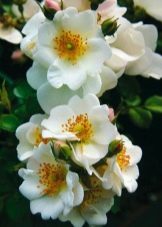

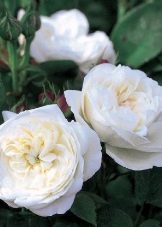
There are also other equally popular types.
Park
This rose is not so much a variety as a separate group. This group, in turn, includes such varieties.
- Blank Double Kubert. Rose of French origin. Its main advantage is considered to be a powerful and pleasant aroma, as well as immunity to various infections. The bushes are usually vigorous. They are capable of reaching a height of 2 meters. At least three buds grow on one branch.
- White Grothendorst. The variety has a very remarkable serrated shape of the petals. The flowers are white and small in diameter, however, from 10 to 15 of them can be located on one branch. The bush itself is tall and extremely strong, its resistance to frost and some infections is quite high.
- Martin Frobisher. This is a small-flowered hybrid of rugose, it is classified as a super winter-resistant varieties. Its flowers are very small in size, and their color is white with a red border. One inflorescence can contain 3-5 pieces. The average height of the bush is 1.5 meters, flowering is abundant. The variety is resistant to diseases, but it also has disadvantages - weak resistance to rain.
- Sir Thomas Lipton. Like the previous varieties, this is a hybrid of colored rugosa, obtained in 1900. Terry snow-white flowers acquire a bright and pleasant aroma over time. The variety has good immunity to infections, in addition, high winter hardiness. But the disadvantages can be safely attributed to a negative reaction to heavy rains.
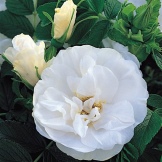
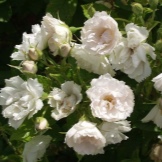
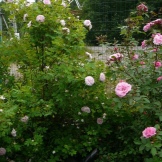
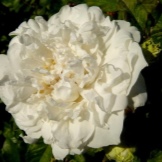
- "Ecuador". Ecuadorian roses have rather large buds, and the maximum stem size is one meter. The smell is weak, however, they are in great demand.
- "Polar bear". Very large buds. Their average size is 16 centimeters. The petals on them are white, but there are also yellowish shades. Leaves of a dark green color grow on the branches. The bush is medium in size, stands upright and level.
- Ice Meilidecor. Created in France in 1996 by the Meilland family. It is a large but very strong bush with many shoots. Their length is at least 70 centimeters. There are also quite a few small thorns present.
- Madame Hardy. Snow-white "Madame Hardy" exudes a lemon scent and blooms several times a year. Its creamy buds gradually acquire a snow-white color. Dense dark green leaves with small teeth grow around the perimeter of the entire plant. This variety has become popular because of its leaves, or rather, their quantity. They completely cover the branch on which the buds are growing, which looks very graceful.

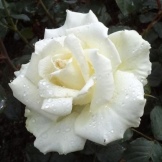
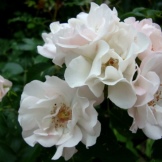
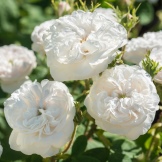
Care rules
Before planting a white rose in your garden, you should familiarize yourself with all the rules for its care.
The most common mistake when growing them is late procedures. A flower like a rose requires constant attention and care, so you cannot forget about it.
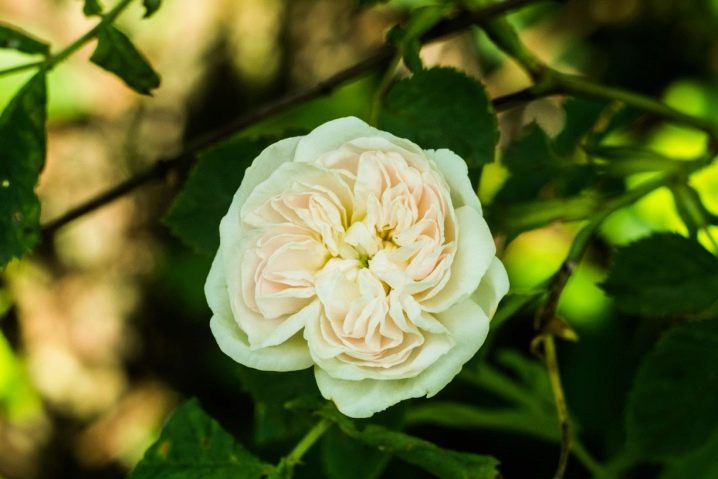
In the spring
The very first thing to do with the onset of spring is to free the plant from its winter shelter. This should be done in a timely manner and slowly, only after all the snow has completely melted and the sun has warmed up the earth. However, the procedure should be carried out no earlier than the first ten days of April. The weather conditions should not be overlooked, because if the temperature is too high, plants can die.


In addition, it is important to remember that spring is a great time to transplant. But one should prepare for it in the fall.Having carried out a transplant, the plants need to be treated with Bordeaux liquid.
Also, this time is notable for the fact that it is at this time that it is best to trim the damaged parts. But for each individual variety, it has its own. It is very important to apply top dressing after it has been carried out, and later to mulch the soil.
When all the procedures have been completed, you can safely proceed to creating supports.

Summer
In summer, white roses require no less care than in spring. It is at this time that flowering occurs, taking away their strength and nutrients from the plants. In addition, high temperatures and lack of moisture inherent in the summer period play a huge role.
Watering should be carried out only with settled water of a comfortable temperature, since cold water can lead to some diseases. For newly planted young bushes, one liter of water will be enough, while older ones need a little more.
It is best to feed roses with potassium-phosphorus fertilizers, and it is recommended to exclude pruning during this period.
If the plants are attacked by moths, it is best to use a soapy solution that is harmless to the roses themselves.

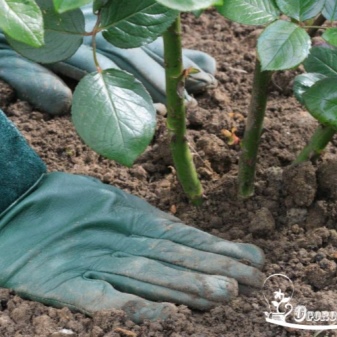
In autumn
The most important task in the fall is to prevent the appearance of unwanted shoots in plants. The first step is sanitary pruning and a shelter for the winter is being built. Then you should change the composition of the soil by applying specialized fertilizers.
After trimming, it is necessary to treat the cut site with antiseptic drugs. This is done to prevent germs and other dangerous organisms from entering the damaged area.
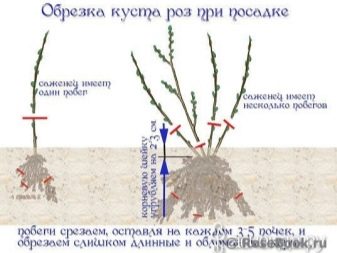

In winter
The most painstaking care for roses is in the winter season. One of the most important tasks is protection from rodents - before the first snow falls, poisonous substances are laid out near the bushes.
With the first thaw, care should be taken to "ventilate" the plants. To do this, it is enough to slightly raise the installed shelter.

Use in landscape design
As stated earlier, white roses are a great decoration for any garden. With the help of them, you can create spectacular combinations that delight the eye.
Not only pastel flowers are suitable for white roses, but also bright or even dark buds. Most often you can find a combination of white and pink or white and lilac. Peach or coffee shades of flowers are also perfect for white roses.
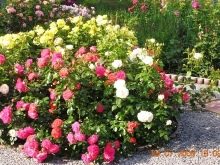


A very bright and striking combination will be a white rose with red, blue, purple or black. However, you should be aware that in no case should you place white and bright yellow roses next to each other. These colors do not match at all.

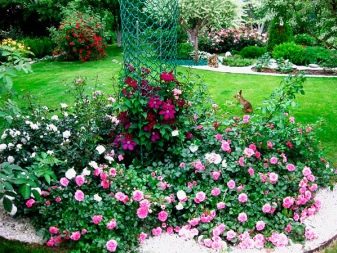
Talking about the place of planting roses, you should show your imagination. This can be the most common flower bed, support for climbing plants, containers and many other household items.
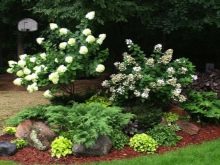


Planting and caring for white roses is a very painstaking and hard work. But with enough patience and the right amount of work, these flowers will grow truly beautiful and worthy of any garden.
For information on what should be the care of roses in spring, see the video below.

































































































The comment was sent successfully.